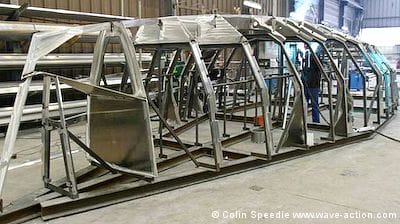There is a strong argument for buying a used boat for long distance cruising. The purchase price is initially more affordable, the boat often comes with a fairly full inventory, and may be well sorted out and ready to go.

Such boats do exist, but experience suggests that the reality is more likely to be just the opposite. The price, which on the face of it may seem attractive, often proves to be less so once the replacement of worn and obsolete equipment has been factored in—refits are never cheap. If your ambitions stretch beyond normal horizons then the equation becomes even more complicated, as suitable boats are few and far between. And upgrading even a well prepared stock boat to meet the needs of a totally independent cruising life will come at a premium price.
The desire for a metal hull narrowed our range of options further. Over several years we’d looked at many steel boats that might have fitted the bill, but all had what might be termed fatal flaws—no insulation, worn out equipment and rust, rust, rust! Such experiences began to divert the search from steel towards aluminum. At the same time more and more highly experienced sailors had turned to this light, durable material for their craft, especially where high latitudes were the destination—think S/Vs Aventura III, Hawk, Morgan’s Cloud, Northabout, Pelagic Australis, Seal, amongst others. Their reasons for making such choices were highly instructive and chimed with our own thoughts, so the search began for a suitable aluminum boat.
Aluminum boats in the UK are very rare indeed, although far more plentiful in Europe. Boat builders in France have long seen the benefits of alloy construction, and the Dutch have followed suit, building on their mastery of the art of building in steel. Excellent used boats do come on the market, but we always seemed to hear about them too late—good boats at sensible prices were snapped up, and we undoubtedly missed a couple of beauties. At the same time, the usual mismatches in terms of our baseline, non-negotiable design features came up time and again.
Scrutiny of the prices helped to concentrate the mind—these boats hold their values incredibly well, a good thing if you own one, less so if you are looking to buy. When we focused on a couple of likely boats, worked out the cost of upgrading them to our requirements and added the inevitable bit extra, there was nothing much between them and a new boat, price wise. When we were faced with buying someone else’s compromise, however good the boat, the decision was made—we’d go for a new build. At least, too, with a new boat we stand a chance of having several years of relatively trouble free cruising.
So far we are happy with that decision. We have been able to build in many desirable custom features at remarkably little extra cost, one of the major advantages of building in alloy, and working with a builder who has done it all before. And we have had a major say in the interior, rig, deck and systems to create a boat that suits us from scratch. Time will tell whether we have got it right.

Hi Colin,
like you I was together with some friends thinking of changing an old wooden boat to a modern alu boat. We did not and here is the reasons: I have had tree fishing boats with aluminium deck houses and they worked very well. They were all functional, dry, warm and easy to maintain and paint. I am a fan of alu in ships based on a long experience. Our goal was to sail in The Arctic and also use the boat in the Scandinavian winter. I first sailed a French Garcia of 16 metres. The Garcia was so strange and original that I could not accept it. We then tried several smaller Ovni boats. As it was of importance that the boat should be comfortable in cold weather, we checked the inside first in cold weather. The foam insolation had several spots with little or no foam. On this spots we found condensation, water and ice. Hatches and windows were single and wet. The frames are connected directly to the alu hull without any insolation. When the frames are insulated from the hull this problem are smaller. We were surprised to find this large condensation problem as the producers of steel boats have solved this problem many generations ago. It is also difficult to repair it since the hole interior must be rebuilt somewhat smaller. We concluded that living aboard some weeks in The Scandinavian winter would be very uncomfortable.
We also found other problems that may be of importance, but possible to fix. We saw 10 Ovnis with Victron isolation transformers. All 10 Victrons were wrongly installed as the primary side were connected to ground (the hull). This may cause corrosion in the hull. All VHFs were connected to ground wrongly. We saw some corrosion by the stanchions, but I do not know the long time development of this bad installations.
We found the ergonomics of the cockpit bad as the sitting benches were to low. The owners used pillows to sit on. At sea this will become wet and freeze to ice and be no good. The hand rails around the helm was soft and weak.
Our conclusion was that the Ovni would be too uncomfortable for our sail area, but with some modifications it could work well in France.
I also feel that the boat builder must be careless or incompetent and I do not do business with such builders.